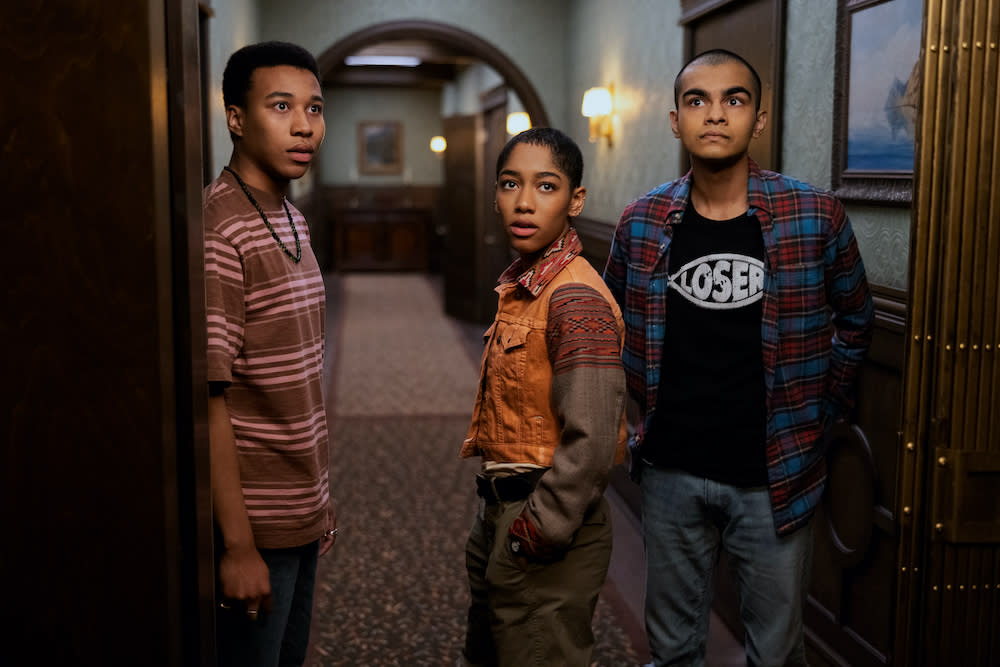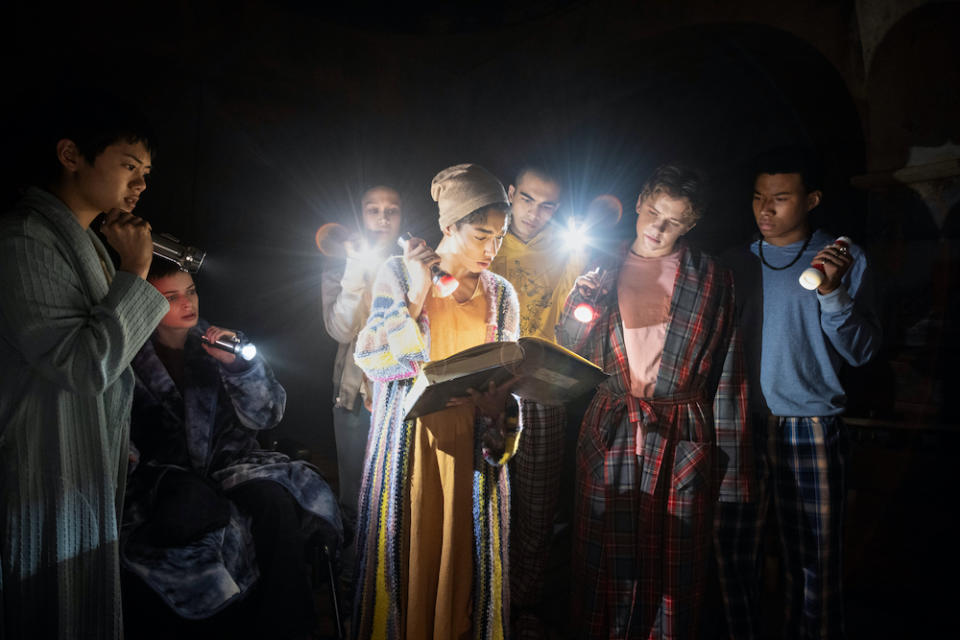‘The Midnight Club’ Review: Mike Flanagan Subverts Death Itself in Cheesy Anti-Horror Stories

- Oops!Something went wrong.Please try again later.
In 2017, a little-known Australian author published an unforgettable book about dying — not death, mind you, but dying. Diagnosed with Stage IV cancer, Cory Taylor’s memoir isn’t about how she “fights” for her life or “battles” a disease; it’s about grounding an experience that, one way or another, we’ll all share. “Dying: A Memoir” acknowledges the dread and sadness surrounding our ultimate fate, but the author steers her story toward advocacy over despair. She wishes more people could acknowledge the simple reality of death with empathy, acceptance, and an open dialogue. After all, it’s far more acceptable to reject news of a loved one’s damning diagnosis — “You’ll beat this thing” or “Don’t talk like that” — than to face the fear together via a real, practical exchange. And for those soon departing, spending your last days hoping and searching for a miracle isn’t necessarily the best use of limited time.
“Dying: A Memoir” comes to mind early and often while watching Mike Flanagan’s latest Netflix series, “The Midnight Club,” but it’s less of a companion piece than a vastly superior delivery device of a similar message. Co-created by Flanagan and Leah Fong (with Flanagan a co-writer on every episode, save for one entry penned only by his brother, Jamie Flanagan) the 10-episode series is adapted from Christopher Pike’s 1994 novel of the same name (as well as the author’s other works). It follows a group of ’90s era college-aged teenagers who live in a hospice for terminally ill youths. The house mission is simple: Brightcliffe provides space for the dying to transition on their own terms — meaning the founder, Dr. Georgina Stanton (Heather Langenkamp), aims to help each patient appreciate life again, rather than spend their final days terrified of death. But the kids’ secret ambition is a little more elaborate, if not antithetical to her teachings: Whoever dies next will give the remaining Midnight Club members some sort of sign from the beyond — to prove it exists, and the end facing the group isn’t really the end after all.
More from IndieWire

EIKE SCHROTER/NETFLIX
Like Flanagan’s previous programs, “The Midnight Club” reexamines and subverts horror tropes standard to a show involving cults, haunted houses, and death lurking around every corner. Instead of watching patients get picked off one by one or some supernatural journey to deliver a message from the afterlife, the series invests in its characters’ emotional perils. Each episode sees them learning to reorient their expectations of Brightcliffe, which then reframes what the audience should expect from “The Midnight Club.”
By now, prospective viewers should be familiar with Flanagan’s brand of horror — more moody than menacing, more gracious than gory — but even for established fans, his latest is his least successful in terms of marrying admirable ambitions with an entertaining story.”The Midnight Club” aspires to change the conversation around death, perhaps for an entire generation of viewers, but such heady (and necessary) ideas aren’t well-embodied by what quickly devolves into a cheesy, scattered, and frustrating tale.
Meet Ilonka (Iman Benson). Introduced while coloring her hair with streaks of red — the dye ominously flooding her white bath tub like blood from an open wound — Ilonka is a hard-working high school senior who’s so excited for college, she skips her classmates’ shindigs to go to a frat party. It’s there, during some awkward flirting, she coughs up actual blood, runs to the bathroom, and sees chilling visions of a mysterious house. From there, events play out in quick succession: She’s diagnosed with thyroid cancer, the treatments don’t work, and her doctors tell her to face the inevitable: It’s time to prepare for the end.
For Ilonka, that means moving to Brightcliffe. She finds the house online (recognizing it from her visions) and pushes her foster father to let her move in. He relents (far too easily, but whatever — “no parents” is baked into the premise), and Ilonka meets her new housemates. There’s Spencer (Chris Sumpter), a typically buoyant presence despite being ousted by conservative parents who can’t accept their gay son; Natsuki (Aya Furukawa), a creative writer who struggles with her mental health; Sandra (Annarah Cymone), a devout Christian whose trust in God helps her cope; Amesh (Sauriyan Sapkota), a fast-talking, quick-witted video game nerd with a heart of gold; Cheri (Adia), an eccentric type the group can’t quite get a read on, but who claims to be the daughter of famous Hollywood actors; Kevin (Igby Rigney), a supportive member of the group and boy-next-door type; and Anya (Ruth Codd), an Irish rebel who’s ready with a sarcastic retort or stubborn rebuttal to any assertion whatsoever.

Eike Schroter / Netflix
Long before Ilonka showed up, this crew kept up an unofficial Brightcliffe tradition: a secret society called, you guessed it, The Midnight Club. At the stroke of 12 a.m., each teen sneaks out of their room and gathers in the library to tell (mostly) scary stories (despite Dr. Stanton giving strict orders to mind the curfew). These meetings start out innocently enough, but as Ilonka spends her days combing through the hospice’s history — tracking down miracle cures and seeking out former guests — the nighttime gatherings become more than a hobby. They’re part of a greater mission.
That doesn’t mean they’re always that interesting. Structurally, “The Midnight Club” could be split into two shows: There’s a serialized story about Ilonka’s journey through the hospice, but there’s also an episodic element, built from the campfire stories told during the Midnight Club. Starring the kids as alternate versions of themselves (as well as a few of Flanagan’s favorite thespians from past productions), the one-off fables tend to provide bits of insight into the teller’s backstory and state of mind, but oh boy are they a drag on the overall show.
Like most episodic anthologies, certain stories are better than others, but a) as homages to various movie genres, they’re all equally bland, and b) each 20-30 minute break from Ilonka & Co.’s reality brings their broader narrative to a screeching halt. Just when it feels like there’s a little momentum behind Ilonka’s investigation into Brightcliffe and her burgeoning relationships there, we’re thrown into a ’90s-era serial killer movie or 1940s film noir spoof. Honestly, I’m still not sure if these stories are supposed to be good or bad; each kid is creating them on their own, so maybe the sloppy storytelling, clichéd trajectories, and grating dialogue are meant as an accurate reflection of how hard it can be to make up a good story on the spot. But that doesn’t make them any easier to sit through, nor would it explain why some of these same issues pop up outside the Midnight Club’s get-togethers.
Because the show’s episodic half is nearly so bad it’s funny, and the entire show’s general goal is to lessen our collective anxiety around death, “The Midnight Club” could be considered Flanagan’s first anti-horror story. In the past, certain viewers have complained that his interpretation of an ever-widening horror genre simply isn’t scary enough. Such arguments are usually useless — since such an objection really comes back to, “This isn’t what I thought it was,” which is only a problem if you only ever want to watch what that you’ve already seen — but they’ll certainly crop up again. “The Midnight Club” barely tries to be frightening. An early Midnight Club yarn uses so many jump scares the characters call out the storyteller for being lazy. Other narrators are chastised for repeating themselves or screwing up the big reveal. Such choices are intentional and help set the show apart from typical horror stories — making clear that the success of “The Midnight Club” doesn’t rest on how much terror it evokes.
But it doesn’t elicit another substantial reaction instead. Predictable twists undermine any suspense, overstretched plot lines create too much slack, and saccharine character arcs undermine any emotional impact. “The Midnight Club” feels so focused on overthrowing conventions that Flanagan neglected to center the series around a story as clear and commanding as its message.
Grade: C
“The Midnight Club” premieres all 10 episodes Friday, October 7 on Netflix.
Best of IndieWire
7 New Netflix Shows in October 2022 — and the Best Reasons to Watch
From 'Reality Bites' to 'Fatal Attraction,' Keep Track of All the Upcoming Film-to-TV Adaptations
Sign up for Indiewire's Newsletter. For the latest news, follow us on Facebook, Twitter, and Instagram.

